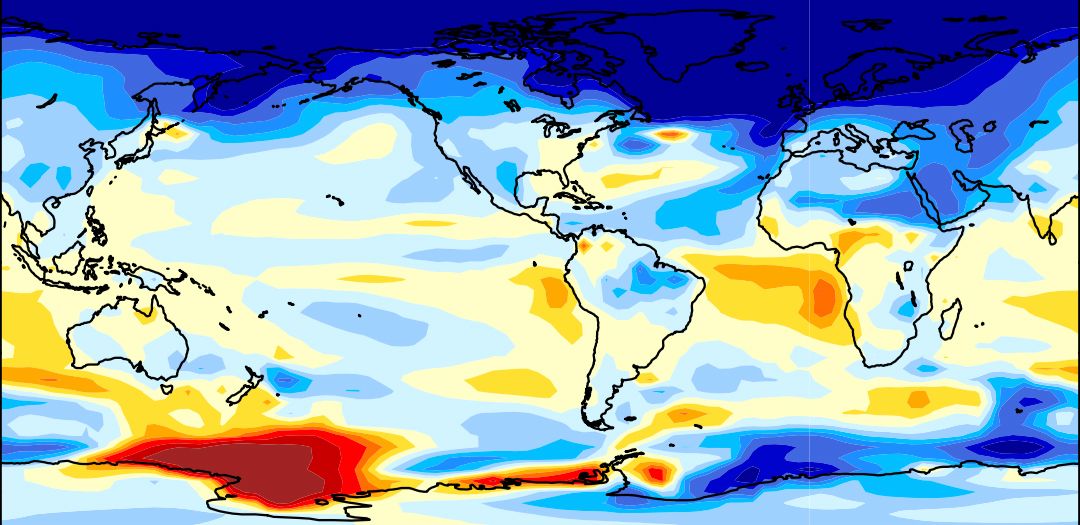Climate Change Could Trigger Collapse of Major Ocean Current

In the 2004 disaster film "The Day After Tomorrow," global warming leads to the failure of an enormous current in the Atlantic Ocean, triggering catastrophic natural disasters and establishing freezing conditions in North America and Europe over a matter of weeks.
That scenario might not be so far-fetched, researchers have found.
The Atlantic Meridional Overturning Circulation (AMOC), a deep-sea system that circulates warm water and helps to regulate Earth's climate, is far less stable than scientists once thought, according to a new study. Under climate-change pressures such as dramatic increases in atmospheric carbon dioxide (CO2), the AMOC could even collapse entirely, resulting in a much colder Northern Hemisphere and a wetter tropical Atlantic region. [Doomsday: 9 Real Ways Earth Could End]
This particular scenario wouldn't happen for hundreds of years — if it happens at all, the study authors wrote. However, computer models used to predict Earth's climate future typically represent AMOC as relatively stable. An unstable AMOC, as described in the study, changes the equation and presents a future several centuries from now in which the current weakens and ultimately fails to recover from repeated disruption, with dire consequences for the global climate.
A climate conveyer belt
AMOC operates like a gigantic climate conveyer belt. In the depths of the Atlantic Ocean, cold, dense waters are carried southward, toward the equator. At the same time, closer to the surface, the current transports heat (in the form of warm, less dense water) from the tropics to the North, where it gets transferred into the atmosphere and warms the air. This heat exchange is what drives and maintains global climate patterns, according to the National Oceanic and Atmospheric Administration.
But if climate models exaggerate the current's stability over time, that can skew the prediction of future risk from climate change, study lead author Wei Liu, a postdoctoral associate in the Department of Geology and Geophysics at Yale University, told Live Science.
This long view of AMOC's stability has also been a long-term project for Liu, who first explored the topic at the University of Wisconsin-Madison as an undergraduate and later incorporated his research into his doctoral thesis while at Scripps Institution for Oceanography, before bringing the investigation to Yale.
Sign up for the Live Science daily newsletter now
Get the world’s most fascinating discoveries delivered straight to your inbox.
Some of Wei's suspicions about the accuracy of the models stemmed from observing how difficult it was for them to replicate sudden shifts in climate in Earth's distant past that were linked to AMOC behavior.
"I found that it is hard for climate models to simulate abrupt AMOC change — collapse — and climate change in paleoclimate, indicating that the AMOC in climate models is overstabilized," Wei said.
Furthermore, observations and analysis of the current have also suggested that the level of stability used in the models is likely exaggerated, he added.
"The significance of our study is to point out a systematic bias in current climate models that hinders a correct climate projection," Wei said in a statement.
Correcting the bias
In the study, Liu and his colleagues corrected for the bias in climate models favoring a stable AMOC, to see the effects of an unstable current. Their simulations increased the amount of atmospheric CO2, and after 200 years elapsed, CO2 levels were double what they were in 1990. About 300 years after that benchmark was reached, the current collapsed.
Once AMOC failed in the simulation, surface temperatures in the North Atlantic Ocean dropped 4.3 degrees Fahrenheit (2.4 degrees Celsius). Northwest Europe cooled, with surface air temperatures dropping as much as 12.6 degrees F (7 degrees C). Meanwhile, the tropical rain belt, a near-continuous band of storms and showers that cycles around Earth close to the equator, moved farther to the south.
Though the study used only one computer model and one global warming scenario, its findings suggest that allowing for an unstable ocean current produces vastly different outcomes, presenting "enormous implications" for climate change on a regional and global level, Wei said.
The findings were published online Jan. 4 in the journal Science Advances.
Original article on Live Science.

Mindy Weisberger is an editor at Scholastic and a former Live Science channel editor and senior writer. She has reported on general science, covering climate change, paleontology, biology and space. Mindy studied film at Columbia University; prior to Live Science she produced, wrote and directed media for the American Museum of Natural History in New York City. Her videos about dinosaurs, astrophysics, biodiversity and evolution appear in museums and science centers worldwide, earning awards such as the CINE Golden Eagle and the Communicator Award of Excellence. Her writing has also appeared in Scientific American, The Washington Post and How It Works Magazine. Her book "Rise of the Zombie Bugs: The Surprising Science of Parasitic Mind Control" will be published in spring 2025 by Johns Hopkins University Press.











